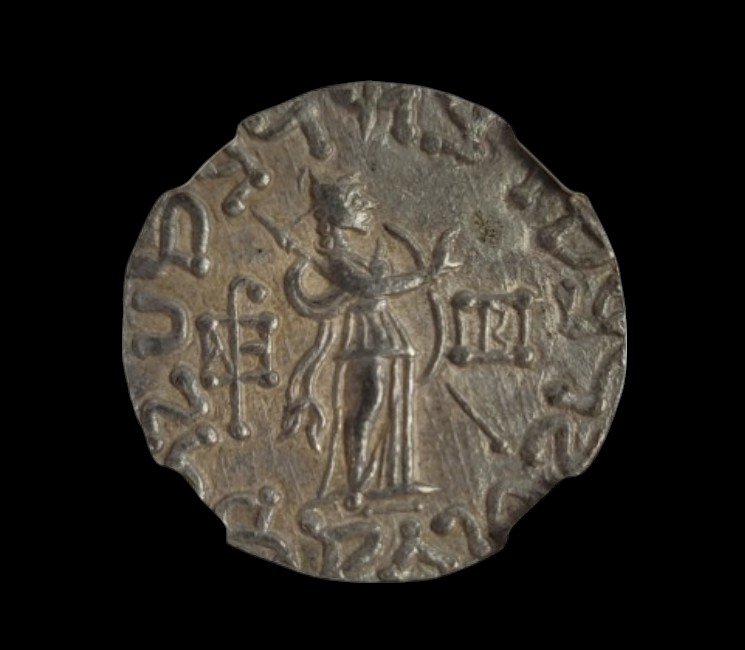 Image 1 of 8
Image 1 of 8

 Image 2 of 8
Image 2 of 8

 Image 3 of 8
Image 3 of 8

 Image 4 of 8
Image 4 of 8

 Image 5 of 8
Image 5 of 8

 Image 6 of 8
Image 6 of 8

 Image 7 of 8
Image 7 of 8

 Image 8 of 8
Image 8 of 8

Tabaristan NGC Certified Slab - Zoroastrian Dabuyid Silver Coin (about 1250 years ago)
This is a professionally graded and certified silver coin from the Dabuyid dynasty of Tabaristan (modern northern Iran), which followed the Zoroastrian religion.
Technical Details:
Format: NGC certified protective slab
Authentication: NGC certified
Note: Coin shown in images is an example only; actual coin may vary
Historical Significance: The Dabuyid dynasty ruled Tabaristan (the mountainous region south of the Caspian Sea in northern Iran) during the early Islamic period, maintaining Zoroastrian religious practices while surrounded by the expanding Muslim caliphates. Zoroastrianism, one of the world's oldest continuously practiced religions, influenced Judaism, Christianity, and Islam with concepts like heaven and hell, judgment after death, and an apocalyptic end of the world. This certified coin represents a fascinating period when Zoroastrian rulers maintained a degree of independence and religious freedom despite being surrounded by Muslim territories. Their distinctive coinage, based on Sasanian silver designs but with unique adaptations, provides tangible evidence of this culturally significant transitional period in Middle Eastern history.
This is a professionally graded and certified silver coin from the Dabuyid dynasty of Tabaristan (modern northern Iran), which followed the Zoroastrian religion.
Technical Details:
Format: NGC certified protective slab
Authentication: NGC certified
Note: Coin shown in images is an example only; actual coin may vary
Historical Significance: The Dabuyid dynasty ruled Tabaristan (the mountainous region south of the Caspian Sea in northern Iran) during the early Islamic period, maintaining Zoroastrian religious practices while surrounded by the expanding Muslim caliphates. Zoroastrianism, one of the world's oldest continuously practiced religions, influenced Judaism, Christianity, and Islam with concepts like heaven and hell, judgment after death, and an apocalyptic end of the world. This certified coin represents a fascinating period when Zoroastrian rulers maintained a degree of independence and religious freedom despite being surrounded by Muslim territories. Their distinctive coinage, based on Sasanian silver designs but with unique adaptations, provides tangible evidence of this culturally significant transitional period in Middle Eastern history.
This is a professionally graded and certified silver coin from the Dabuyid dynasty of Tabaristan (modern northern Iran), which followed the Zoroastrian religion.
Technical Details:
Format: NGC certified protective slab
Authentication: NGC certified
Note: Coin shown in images is an example only; actual coin may vary
Historical Significance: The Dabuyid dynasty ruled Tabaristan (the mountainous region south of the Caspian Sea in northern Iran) during the early Islamic period, maintaining Zoroastrian religious practices while surrounded by the expanding Muslim caliphates. Zoroastrianism, one of the world's oldest continuously practiced religions, influenced Judaism, Christianity, and Islam with concepts like heaven and hell, judgment after death, and an apocalyptic end of the world. This certified coin represents a fascinating period when Zoroastrian rulers maintained a degree of independence and religious freedom despite being surrounded by Muslim territories. Their distinctive coinage, based on Sasanian silver designs but with unique adaptations, provides tangible evidence of this culturally significant transitional period in Middle Eastern history.
Tabaristan or Tabarestan (Persian: طبرستان, romanized: Ṭabarestān, or Mazanderani: تبرستون, romanized: Tabarestun, ultimately from Middle Persian: ![]() , Tapur(i)stān), was a mountainous region located on the Caspian coast of northern Iran. It corresponded to the present-day province of Mazandaran, which became the predominant name of the area from the 11th-century onwards.[1]
, Tapur(i)stān), was a mountainous region located on the Caspian coast of northern Iran. It corresponded to the present-day province of Mazandaran, which became the predominant name of the area from the 11th-century onwards.[1]
Tabaristan was named after the Tapurians, who had been deported there from Parthia by the Parthian king Phraates I (r. 176–171 BC).[2][3] At the advent of the Sasanians, the region, along with Gilan and Daylam, was part of the Padishkhwargar kingdom of king Gushnasp, who is mentioned in the Letter of Tansar. He submitted to the first Sasanian King of Kings (shahanshah) Ardashir I (r. 224–242 AD) after being guaranteed to keep his kingdom.[4][5] His line would continue ruling Padishkhwargar until the second reign of Kavad I (r. 488–496, 498–531), who removed the dynasty from power and appointed his son Kawus in its stead.[6] Under the Sasanians, Tabaristan enjoyed considerable autonomy.[1] They most likely left most of the affairs to the locals. The mint signature of "AM" is generally presumed to be an abbreviation for the Amul, the main city of the region.[7] The first known Sasanian monarch to have minted coins with the signature was Bahram V (r. 420–438),[8] whilst the last was Boran (r. 630–630, 631–632).[7]
In the 640s, the Dabuyid prince Gil Gavbara (r. 642–660), who was a great-grandson of shahanshah Jamasp (r. 496–498/9), conquered all of Daylam and Gilan and planned on extending his conquests to Tabaristan. Its governor, Adhar Valash, requested the aid of (shahanshah) Yazdegerd III (r. 632–651). Being unable to suppress the revolt, Yazdegerd III instead acknowledged Gil Gavbara as the ruler of the regions, presumably to deter him from creating an independent realm. Gil Gavbara was given the titles of Padashwārgarshāh (shah of Padishkhwargar) and "Ispahbad of Khorasan", possibly indicating Dabuyid rule in eastern Iran. Gil Gavbara maintained the independence of his realm during the Arab invasion of Iran, which had resulted in the collapse of the Sasanian Empire.[9][10]












